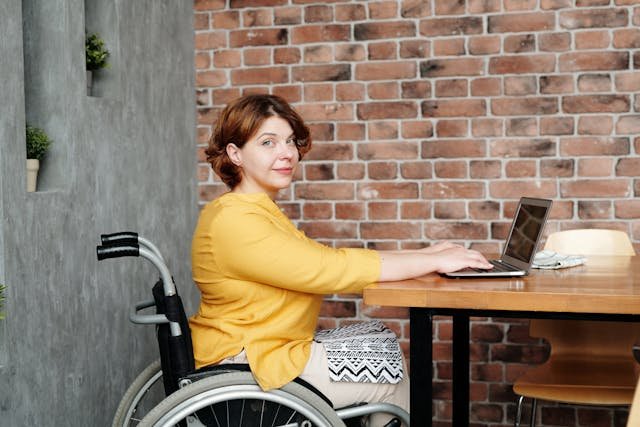Your first prosthetic fitting is one of the most important steps in your recovery after amputation. It marks the beginning of a new chapter—one where you regain movement, independence, and confidence. But like every new experience, it can bring a mix of emotions. You may feel excited, anxious, curious, or even a little overwhelmed. That’s completely normal.
At Robobionics, we’ve guided hundreds of individuals through this important phase. Whether you’re preparing for a below-knee or above-knee prosthetic, being ready—physically and mentally—makes the journey smoother. This article will help you understand what to expect, how to prepare, and what steps can make your first prosthetic fitting a positive and empowering experience.
Understanding the Purpose of Your First Fitting
Before your final prosthetic is made, you’ll go through a fitting process to create a device that matches your body’s shape, strength, and movement needs. This first fitting lays the foundation for your comfort and success with the prosthesis.
Why Fitting Matters in the Recovery Process

A prosthetic is not something you just wear—it becomes part of your body. The way it fits affects how you walk, how much pain or ease you feel, and how confident you are during daily activities. A good fit can make movement feel natural. A poor fit can lead to discomfort, pressure sores, or instability.
That’s why this first fitting is not rushed. It’s a detailed process, where your prosthetist observes your limb, listens to your feedback, and adjusts the socket and alignment carefully. The goal is to build a device that feels like an extension of your body.
At Robobionics, we take the time to get this right. We use precise tools, soft materials, and multiple sessions if needed to ensure your first experience is safe and comfortable.
What Happens During the First Appointment
Your first prosthetic fitting won’t involve walking right away. It usually starts with an evaluation. Your prosthetist will examine your residual limb—its shape, volume, skin condition, and strength. They will ask about your goals, your daily routine, and what kind of movement you hope to return to.
Based on this information, a test socket will be made. This is a temporary, clear plastic version of the prosthetic socket. It allows the prosthetist to see how your limb fits inside and how pressure is distributed. You may be asked to stand, shift weight, or walk short distances with assistance.
At Robobionics, we often combine this session with video gait analysis, which shows us how your body is moving in real time. It helps us make even more accurate changes to improve balance and reduce stress on your joints.
Building Trust with Your Prosthetic Team
Your prosthetist is not just a technician—they are your partner in recovery. Building trust from the very beginning helps you feel more at ease during the fitting. If you feel pain, pressure, or uncertainty, it’s important to speak up. Every bit of feedback helps improve the fit.
This relationship matters because the prosthetic fitting is not a one-time event. Your limb will continue to change, especially in the first few months. You’ll need follow-up visits, minor adjustments, and regular check-ins. Having a prosthetist you trust makes this process feel supportive, not stressful.
Robobionics believes in open, honest communication. We listen closely, explain clearly, and involve you in every decision so that your prosthetic becomes something you’re proud to wear.
Preparing Your Residual Limb for the Fitting
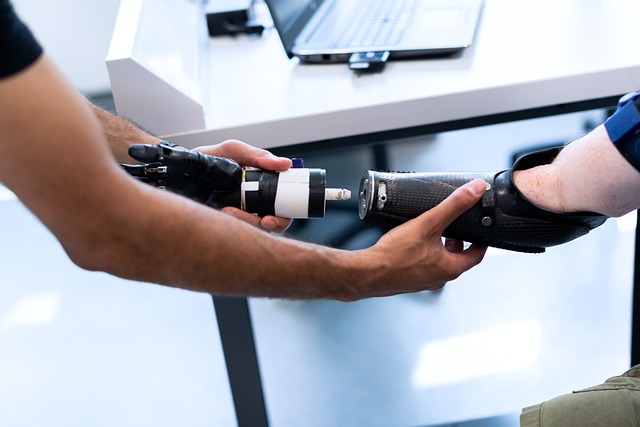
Your limb has been healing since surgery, but now it needs to be prepared for the next stage—fitting and weight-bearing. Taking care of your limb properly in the days and weeks before your appointment can improve comfort and speed up the fitting process.
Managing Swelling and Limb Shaping
Swelling is a normal part of healing after amputation. But before a prosthetic socket can fit correctly, that swelling must go down. You can help this process by wearing compression bandages or shrinker socks as recommended by your doctor or prosthetist. These apply gentle pressure that encourages the limb to shape evenly.
The shape of the limb is important. A well-shaped residual limb is more likely to fit securely in the socket and reduce the need for frequent adjustments. Limb shaping also helps with balance and weight distribution when you begin walking.
Robobionics provides pre-fitting kits that include liners and shrinkers with easy instructions. These tools are designed to protect the skin while encouraging the right limb shape.
Caring for Skin and Managing Sensitivity
The skin on your residual limb will be under pressure when it sits inside the prosthetic socket. That’s why it’s important to keep the skin healthy, clean, and moisturized. Gently wash your limb with mild soap every day, dry it carefully, and check for signs of irritation or injury.
If you notice dry spots, redness, or discomfort, tell your prosthetist before the fitting. These issues should be addressed early, as they can become worse with socket pressure.
Many users also experience sensitivity in the limb. Nerves are adjusting, and the limb may feel tender or tingly. Simple touch therapy—like gently rubbing the limb with a soft cloth—can help desensitize it and make it easier to wear the socket.
At Robobionics, we guide users through a full limb care routine and provide tips to ease sensitivity before fitting begins.
Strengthening Muscles and Joints
Your body will rely on different muscles now to stand, walk, and maintain balance. Preparing those muscles before your first fitting makes a big difference. Gentle exercises that focus on your hips, thighs, and core will help you control the prosthetic better when the time comes.
Even simple stretches or seated movements can help. You don’t need a gym or complex equipment. What matters is consistency and safe technique. Your therapist may also teach you how to position your limb to avoid contractures or tight joints, which can make fitting harder.
Robobionics works closely with rehab teams to design personalized exercise plans for each user. This keeps your body ready and reduces stress during the first steps with the prosthetic.
What to Wear and Bring to Your First Fitting
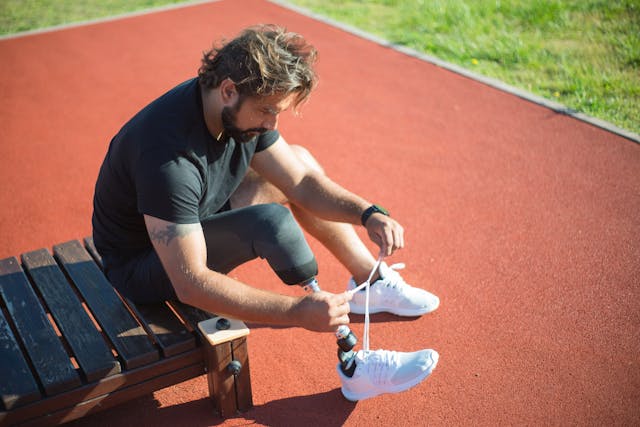
The first fitting is a big day, and being comfortable helps everything go more smoothly. What you wear and bring can make a real difference in how relaxed and prepared you feel during your session. Keeping things simple, clean, and practical will help you focus fully on the experience.
Choosing the Right Clothes for Your Appointment
You’ll likely need to remove or adjust clothing during the fitting so your prosthetist can access your residual limb. That’s why loose, comfortable clothing is the best choice. If you’ve had a below-knee amputation, consider wearing shorts or loose pants that can be rolled up easily. For above-knee fittings, a pair of comfortable shorts or a skirt is ideal.
The goal is to avoid anything tight or restrictive around the limb area. Breathable fabrics are better, especially in warm weather. It’s also a good idea to wear supportive shoes or sneakers on your sound foot. This gives you better balance when you stand or take assisted steps during the session.
At Robobionics, we create a calm and private environment so users can feel comfortable in whatever they wear. We’re happy to guide you in choosing what’s best based on your level of amputation.
Bringing the Essentials for a Smooth Session
Before you leave home, gather a few basic items. Bring any compression socks, liners, or wraps you’ve been using during healing. Your prosthetist may want to see how they’ve shaped your limb and how they feel when worn. If you have past medical records, surgical notes, or therapy reports, bring those too. These details help your prosthetist understand your recovery so far.
It’s also helpful to bring a notebook or keep notes on your phone. You may receive advice, follow-up instructions, or tips during the fitting, and writing them down can help you remember later. And don’t hesitate to bring a family member or friend. Having someone familiar nearby can make the experience more supportive and less stressful.
At Robobionics, we welcome caregivers and companions. We believe that recovery is a team journey, and we’re happy to include your support system in every step.
Being Mentally Ready for the Session

It’s natural to feel a little nervous before the fitting. After all, it’s a big step. Remind yourself that you don’t have to do everything perfectly. The fitting is not a test—it’s a process. You’ll be guided, supported, and encouraged through each movement. There’s no pressure to walk a certain distance or balance without help.
If you feel unsure or emotional during the session, speak openly. Your prosthetist understands that this is a sensitive time. Being honest helps them make the experience more comfortable and the prosthetic more personalized.
Robobionics takes pride in offering a human-first approach. We focus on empathy, listening, and building trust—because how you feel during your fitting matters just as much as how the device fits.
Managing Expectations and Understanding the First Fitting Experience
Walking into your first prosthetic fitting with realistic expectations is key to having a positive experience. While this moment brings hope and excitement, it’s also important to understand that this is the beginning of a gradual process. The fitting is not about walking perfectly on day one—it’s about starting gently, learning step by step, and giving your body time to adjust.
It’s Not Your Final Prosthesis—And That’s Okay
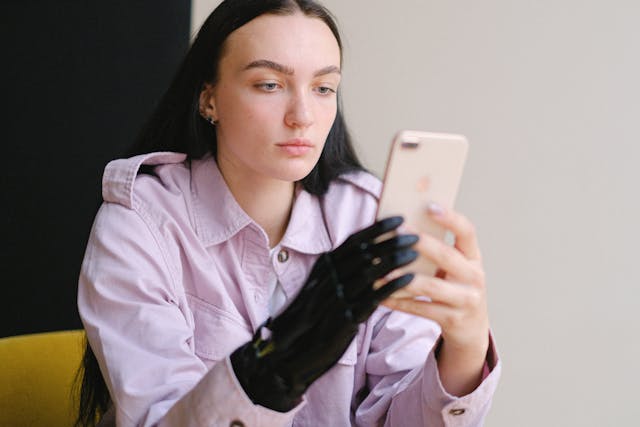
During your first session, you won’t be walking out with your final prosthesis. In most cases, you’ll be wearing a test socket or a temporary fitting model. This is a starting point. It helps your prosthetist study how your limb fits into the device, how you distribute your weight, and how the prosthetic responds to your movements.
This trial version may feel strange at first. You might notice pressure in certain areas or slight discomfort while standing. This is part of the process. These feelings help guide the adjustments your prosthetist will make. It’s not meant to be perfect yet—it’s meant to give useful feedback.
At Robobionics, we always explain what each part of the fitting means. We never rush toward the final device. We take time to understand how your body moves and how your prosthetic should support that movement in real life.
Don’t Expect to Walk Right Away Without Support
Even if your fitting goes well and you stand with the prosthetic, you may not walk independently right away. That’s completely normal. Many people begin by walking with parallel bars, a walker, or with help from a therapist. Your muscles, joints, and mind are just beginning to reconnect. The focus is on stability and safety—not speed.
This is also the moment when your therapist might get involved to help guide early weight shifts, balance practice, and simple steps. The idea is to build muscle memory and gently wake up your body’s natural walking rhythm.
Robobionics supports each user with post-fitting movement coaching. Whether it’s your first step or your hundredth, we’re focused on helping you move with confidence and control.
Feeling Overwhelmed Is Normal—and It Will Pass
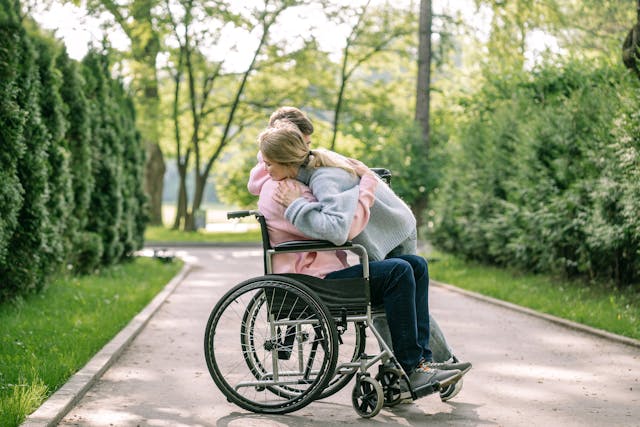
For many people, the first fitting is emotional. It can bring up feelings you didn’t expect—relief, fear, hope, or even sadness. This is completely normal. The prosthetic is a reminder of everything you’ve been through and everything you’re working toward. Letting yourself feel those emotions helps you move through them.
If you feel frustrated or tired after the session, give yourself space to rest and reflect. This is just the beginning of a new part of your life. There is no deadline, no race. Progress happens when you allow yourself to go at your own pace.
At Robobionics, we treat every user with care, not just as a patient but as a person. Our team is trained to offer emotional support as much as physical care, so your journey feels empowering from the inside out.
Conclusion
Your first prosthetic fitting is not just about getting a device—it’s about taking a meaningful step toward reclaiming your independence, confidence, and movement. It’s a moment filled with emotion, learning, and hope. While the process may feel unfamiliar at first, knowing what to expect and how to prepare can make it a powerful and positive experience.
The road to recovery doesn’t begin with the final prosthesis—it begins with showing up for that first fitting, caring for your limb, building trust with your prosthetist, and allowing your body and mind to adjust in their own time. Each small step leads to strength, and each adjustment brings you closer to comfort and mobility.
At Robobionics, we believe that every fitting is a partnership. We walk with you from your first session to your final steps—and beyond. We bring experience, care, and a deep respect for your journey. Whether you’re just starting or already preparing for your appointment, we’re here to guide you, answer your questions, and support your goals with compassion and precision.
If you’re getting ready for your first prosthetic fitting or simply want to learn more, reach out to Robobionics today. Book a free consultation and take your first step forward—with the team that puts your recovery first.



